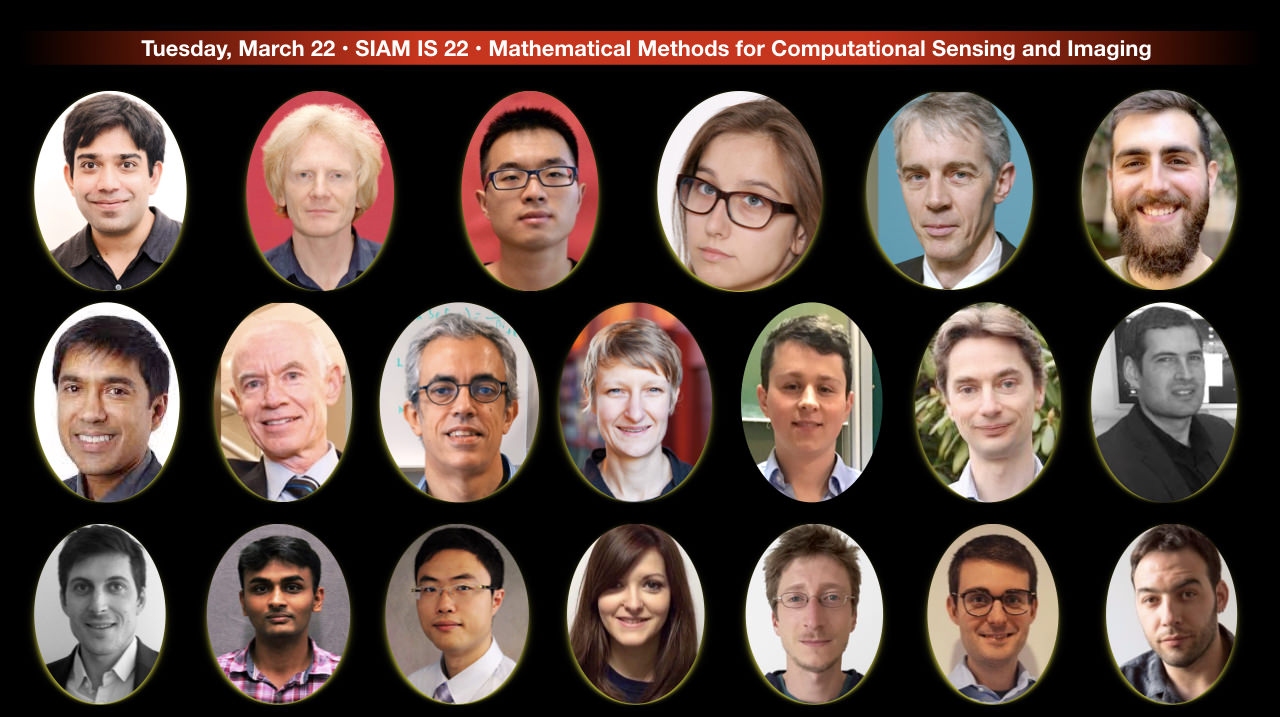SIAM Conference on Imaging Science (IS22)
Slides from Mini-symposium on Mathematical Methods for Computational Sensing and Imaging
Overview of the Session
Traditional sensing or imaging methods are pivoted on a “capture first, process later” philosophy. Here, the recovery/restoration is typically decoupled from the acquisition. This fundamentally limits the applicability of mathematical algorithms because if the sensors result in information loss of any form, the algorithms may no longer be able to achieve their guaranteed performance.
In contrast, the emerging field of Computational Sensing and Imaging (COSI) is based on a joint design of hardware and algorithms; one relies on a carefully optimized capture process yielding encoded measurements from which the information is decoded using mathematically guaranteed recovery algorithms. In recent years, the COSI approach has enabled a number of breakthroughs and continues to inspire new research.
The goal of this session is to bring together interdisciplinary efforts that push frontiers by exploiting a co-design of novel acquisition and mathematical methods. Thus inspiring further investigation into mathematical algorithms. The session is composed of 12 speakers focusing on 3 different aspects of COSI. The talks focus on thematic subtopics that (a) inspire new acquisition, (b) showcase unconventional imaging frontiers and (c) demonstrate new algorithmic capabilities.
By bringing interdisciplinary efforts together, we hope to inspire an end-to-end thinking where mathematical ideas (a) facilitate new algorithms and (b) help conceptualize novel hardware/acquisition.
| S1 | Unlimited Sensing: Computational Sensing and Imaging via Modulo Non-Linearities Ayush Bhandari Imperial College London, United Kingdom | Link |
| S1 | FRI Imaging of Laminar Images from Its Samples Along an Unknown Trajectory Thierry Blu and updated Ruiming Guo Chinese University of Hong Kong, Hong Kong | Link |
| S1 | Lippmann Photography Gilles Baechler*, Arnaud Latty, Michalina Pacholska, Martin Vetterli, and Adam Scholefield *Google Research and EPFL, Switzerland | Link |
| S1 | Overcoming Dead Time Limitations for Imaging with Single-Photon Detectors Joshua Rapp* and Vivek Goyal *Mitsubishi Electric Research Laboratories and Boston University | Link |
| S2 | A Conditional Normalizing Flow Model for the Posterior Distribution Overcomes Inherent Instabilities in Learning-Based Ill-Posed Inverse Problem Solvers Yuqi Li and Yoram Bresler University of Illinois at Urbana-Champaign, USA | Link |
| S2 | Block-Gaussian-Mixture Priors for Hyperspectral Images Mario T. Figueiredo Instituto Superior Tecnico, Portugal | Link |
| S2 | Jointly Optimising Acquisition and Image Reconstruction of Tomographic Measurements Carola-Bibiane Schönlieb Ferida Sherry University of Cambridge, United Kingdom | Link |
| S2 | Deepfake Data for Physics-Based Imaging Laurent Demanet Massachusetts Institute of Technology | Link |
| S3 | Diffraction-Unlimited Imaging through Computational Sensing Aurélien Bourquard* and Nicolas Ducros *Massachusetts Institute of Technology, USA and Université de Lyon, France | Link |
| S3 | Image Deblurring at the Photon Limit: Poisson Likelihood Meets Algorithm Unrolling Yash Sanghvi, Abhiram Gnanasambandam, and Stanley H. Chan Purdue University, USA | Link |
| S3 | Multiband Image Fusion under Spectrally Varying Spatial Blurs - Application to Astronomical Imaging Claire Guilloteau*, Thomas Oberlin**, Olivier Berné*** and Nicolas Dobigeon*** *INSA de Rouen, France, **ISAE-SUPAERO, France, *** Universite de Toulouse, France | Link |
| S3 | Ultrasound Full-Waveform Inversion for Neuroimaging Oscar Calderon Agudo, Javier Cudeiro, Carlos Cueto, George Strong, Oscar Bates, Mike Warner, Mengxing Tang, Parashkev Nachev* and Lluis Guasch Imperial College London, UK and *University College London, UK | Link |
